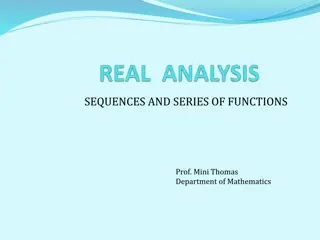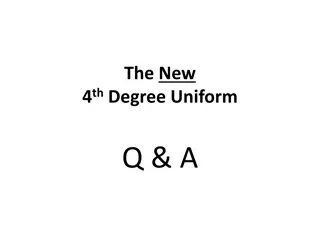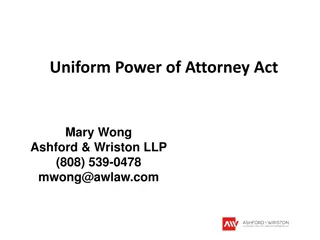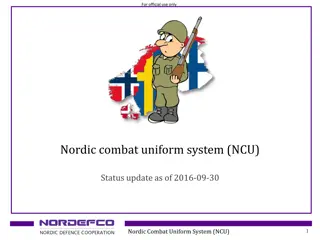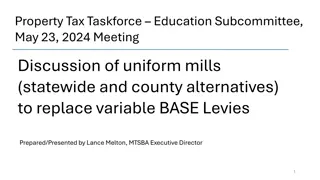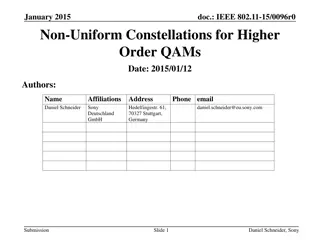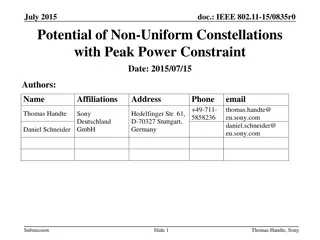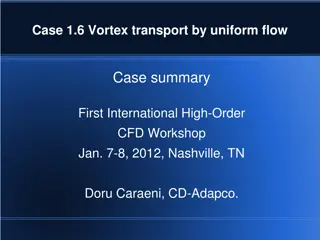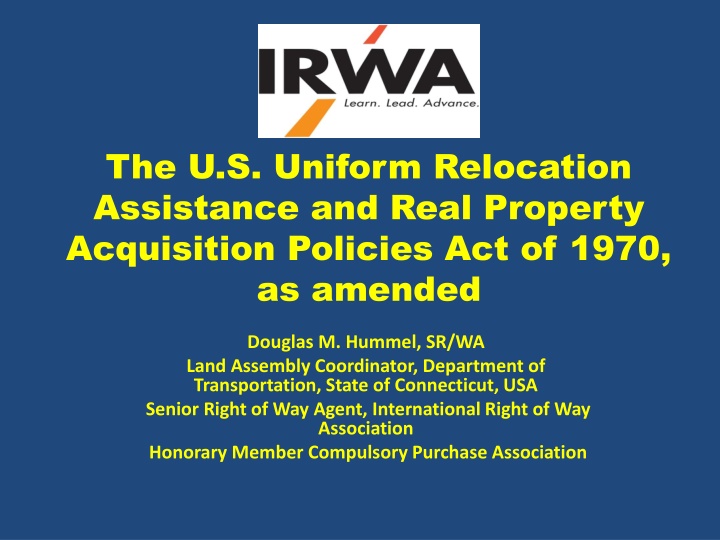
The U.S. Uniform Relocation Assistance and Real Property Acquisition Policies Act
Dive into the details of the U.S. Uniform Relocation Assistance and Real Property Acquisition Policies Act of 1970, its amendments, the Takings Clause, and the Uniform Act. Explore the implications of just compensation, fair market value, and eminent domain in property acquisitions and public use cases.
Download Presentation

Please find below an Image/Link to download the presentation.
The content on the website is provided AS IS for your information and personal use only. It may not be sold, licensed, or shared on other websites without obtaining consent from the author. If you encounter any issues during the download, it is possible that the publisher has removed the file from their server.
You are allowed to download the files provided on this website for personal or commercial use, subject to the condition that they are used lawfully. All files are the property of their respective owners.
The content on the website is provided AS IS for your information and personal use only. It may not be sold, licensed, or shared on other websites without obtaining consent from the author.
E N D
Presentation Transcript
The U.S. Uniform Relocation Assistance and Real Property Acquisition Policies Act of 1970, as amended Douglas M. Hummel, SR/WA Land Assembly Coordinator, Department of Transportation, State of Connecticut, USA Senior Right of Way Agent, International Right of Way Association Honorary Member Compulsory Purchase Association
The Takings Clause The last twelve words of the 5th Amendment to the U.S. Constitution state, .; nor shall private property be taken for public use, without just compensation.
The Takings Clause (Continued) Since Chicago B. & Q. Railroad Co. v. Chicago in 1897, the courts have held that the 14th Amendment to the U.S. Constitution extends the Takings Clause to the States.
The Takings Clause (Continued) The U.S. Supreme Court has consistently held that the Federal Government and the individual States have the power of eminent domain, but are limited by requiring that just compensation be paid for private property taken for public use .
The Takings Clause (Continued) When determining compensation, normally fair market value is used. Speculative schemes, in which the owner claims the property was intended to be used, are not considered.
The Takings Clause (Continued) In United States v. 50 Acres of Land (1984), the U.S. Supreme Court wrote, The Court has repeatedly held that just compensation normally is measured by the fair market value of the property at the time of taking contemporaneously paid in money.
The Uniform Act The Uniform Relocation Assistance and Real Property Acquisition Policies Act of 1970, as amended (UA), is intended to codify how just compensation, in the form of fair market value and relocation assistance , are determined and distributed for Federally- funded projects.
The Uniform Act (Continued) Though the States have statutes and constitutional provisions addressing the Takings Clause, all States have now adopted the UA for all projects regardless of the funding source.
The Uniform Act (Continued) The concept of the willing seller/willing buyer in valuation, negotiation and compensation.
The Uniform Act (Continued) It is constitutionally and morally incumbent on acquiring authorities to do no harm and make property owners whole .
The Uniform Act (Continued) Fair market value and relocation assistance are separate and distinct areas of just compensation.
The Uniform Act (Continued) Fair market value for land and permanent appurtenances.
The Uniform Act (Continued) Relocation assistance to owner/occupants and tenants for replacement housing payments, mortgage differential payments, moving costs, business reestablishment payments, down payment assistance, in lieu of payments and other relocation assistance.
The Uniform Act (Continued) Avoiding the adversarial relationship with owners, tenants and the general public: 1. Fair Market Value Offer 2. Transparent process with shared information 3. Negotiating in good faith 4. Full Realization of Relocation Benefits
Sound Expensive? 1. 81% acquired through closing for original offer 2. 4% acquired through closing as negotiated settlement 3. 15% acquired through eminent domain 4. A third of those are appealed (5% of total acquisitions) 5. Two thirds of those are litigated (3% of total acquisitions)
Only 3 out of every 100 acquisitions are litigated.
Acquisition/Relocation Delivery Times Partial Acquisitions: 6-9 months Residential acquisitions with relocation: 12- 15 months Commercial/Industrial acquisitions with relocation: 15-18 months
Advantages of UA Provisions Fewer adversarial acquisitions Minimal litigation Better public relations/perception Shorter delivery time Lower cost Consistency across schemes
Advantage not UA related Acquiring entities pre-possess eminent domain authority through Federal and State constitutions and statutes. Focus of public involvement and scheme approval is merits of the project, not execution of the land assembly.
Thank you Questions and Discussion Douglas M. Hummel, SR/WA





